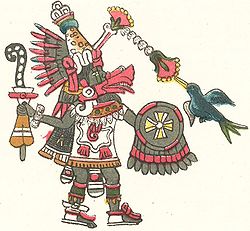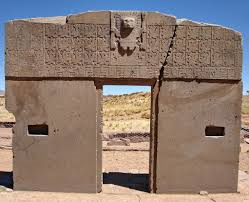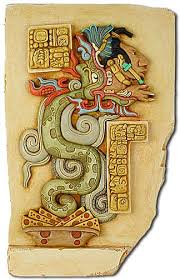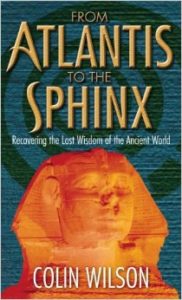Aztecs
Honoré, Pierre
Pierre Honoré was the author of In Quest of the White God[956], which explored the legends that persisted among the natives of Central and South America of white pre-Columbian visitors, revered as gods, that had come from the east. Individual ‘gods’ were remembered as Kukulcan by the Maya and Quetzalcoatl by the Toltecs and Aztecs. Honoré proposed that these ‘deities’ had come from Crete and brought their script with them and since the use of Linear A & B ceased around 1400 BC, the transatlantic visits must have taken place before that date.
Honoré’s book was later republished as In Search of Quetzalcoatl, which can be read online(a). Unfortunately, Honoré’s work has been seen as racist and is often used now by white extremists.
Jason Colavito has delivered a characteristically harsh review of the ‘White Gods’ school of thought.(b)
Quetzalcoatl
 Quetzalcoatl is a Mesoamerican deity, whose name in the local Nahuatl language means ‘feathered serpent’. To the Aztecs he was a creator god and also had a parallel in Mayan culture to whom he was known as Kukulcan or Gucumatz.
Quetzalcoatl is a Mesoamerican deity, whose name in the local Nahuatl language means ‘feathered serpent’. To the Aztecs he was a creator god and also had a parallel in Mayan culture to whom he was known as Kukulcan or Gucumatz.
For some centuries it has been generally thought that the Aztec Emperor Moctezuma II initially believed that Hernán Cortés’ arrival to be the anticipated return of their deity Quetzalcoatl. The veracity of this story has come under increased attack, exemplified by a paper from Jordan Baker(b).
It is a commonly held belief among Mormons that Quetzalcoatl was Jesus Christ!
More widespread and a little less contentious is the idea that St. Thomas the Apostle was Quetzalcoatl(e). “Within two decades of the Conquest, Quetzalcoatl was identified with St. Thomas, the wandering apostle. Since that time Quetzalcoatl has been described as a Viking, a Chinese Explorer, an extraterrestrial, Moses, and Jesus Christ. Similarly, most Mormons assume that the legends of Quetzalcoatl were simply distorted reminiscences of the visit of Christ to the New World as detailed in the Book of Mormon”(f).
An Indian website vehemently disputes the association of St. Thomas with Quetzalcoatl and for good measure also argues against the idea of St. Thomas in India!(g)
Harold T. Wilkins claimed [363.97] that Quetzalcoatl was from Atlantean Brazil.
Pierre Honoré claimed[0956] that these white gods had come from the region of Crete and had brought with them their script. As Linear A & B had both ceased being used by 1400 BC, Honoré surmised that visits of these deities had taken place before that date.
Lewis Spence also claimed an Atlantis connection for Quetzalcoatl, identifying the Mesoamerican deity as Atlas.
Daniel Fleck had some interesting thoughts on Quetzalcoatl(c).
Christian O’Brien has proposed that Quetzalcoatl had been one of the Sages who originated in Sumeria and travelled the world spreading advanced knowledge, including astronomy and megalith building [1797.117]!
>In 1900 Peter de Roo concluded, “that Quetzalcoatl was a Christian prelate who landed in America, accompanied by several inferior missionaries and a number of people from some part of Christian Europe, and that he established a settlement in the territories of the Mexican empire or, perhaps, on the eastern coasts of our United States, from whence they eventually extended their race and religion along the Mexican Gulf.” [890+.1.582]<
These ideas are just pure conjecture but are relatively tame compared with the wilder speculations of writers such as Peter Kolosimo, who “claimed that the legends actually describe a race of white men who were born in spaceships and migrated to Atlantis; then after Atlantis was destroyed, they moved to the Americas to be treated as “white gods” by the “primitive earth-dwellers.”(a)
[890.1.]+ https://archive.org/details/historyamericab02roogoog vol.1
(a) https://en.wikipedia.org/wiki/White_gods
(b) The Real Story of the ‘Bearded God’ Named Quetzalcoatl | Ancient Origins (ancient-origins.net)
(e) http://gnosis.org/thomasbook/ch20.html
(f) https://sunstone.org/wp-content/uploads/sbi/articles/055-06-10.pdf
Mexcaltitán
 Mexcaltitán is a small inhabited island in North West Mexico that is laid out with concentric streets intersected by two perpendicular avenues(a). Some locals compared its layout to that of old maps of Tenochtitlán the legendary capital of the Aztecs, which in turn has been proposed as having a connection with Atlantis. The idea is totally fanciful and does not stand up to the most cursory examination.
Mexcaltitán is a small inhabited island in North West Mexico that is laid out with concentric streets intersected by two perpendicular avenues(a). Some locals compared its layout to that of old maps of Tenochtitlán the legendary capital of the Aztecs, which in turn has been proposed as having a connection with Atlantis. The idea is totally fanciful and does not stand up to the most cursory examination.
(a) https://www.briannissen.com/ (see under texts)
Toltecs, The *
The Toltecs were the predecessors of the Aztecs in central Mexico. It is generally accepted that they ruled between the 10th and 12th centuries AD. Some rather pathetic attempts by Theosophists and New Agers have been made to link the Toltecs with Atlantis. Annie Besant, the theosophist, informed us that the Toltecs were 27 feet tall!
William Scott-Elliot, also a theosophist, described the Toltecs as “averaging about eight feet during the period of their ascendency, but of course dwindling, as all races did, to the dimensions that are common today.”(a)
In the Toltec city of Tula, in the Mexican state of Hidalgo are 15-foot high statues known as Atlantes, which is also an architectural term used to describe supporting columns carved in the shape of a man.(b)
Nevertheless, Dominique Görlitz has written two-part article for Atlantisforschung in which he offers the suggestion that the Toltecs had been influenced by Basque visitors(c). “In addition to the well-known cultural parallels between the peoples of the Old and New Worlds, many Native American cultures have old myths about foreign culture bringers that relate to the beginnings of their culture and agriculture.”
(a) https://www.sacred-texts.com/atl/soa/soa17.htm
(b) Tula – Mysterious City of the Toltecs – The Maritime Explorer (archive.org) *
Buelna, Eustaquio,
 Eustaquio Buelna (1830-1907) was a Mexican lawyer, educator and philologist. He believed(a) that the Toltecs and the Aztecs were of the Nahuatl race and were originally from Atlantis, submerged in the Atlantic, but migrated to North America and eventually to the Valley of Mexico via the Gila and Colorado rivers.
Eustaquio Buelna (1830-1907) was a Mexican lawyer, educator and philologist. He believed(a) that the Toltecs and the Aztecs were of the Nahuatl race and were originally from Atlantis, submerged in the Atlantic, but migrated to North America and eventually to the Valley of Mexico via the Gila and Colorado rivers.
Survivors
Survivors of the Atlantean destruction are a reasonable expectation given the extent of its influence as described by Plato. The fact that its rulers only met every few years suggests a geographical spread that must have left some, if not most, of the confederation intact, irrespective of the location of the earthquake’s epicentre. Some have proposed that survivors migrated to an extensive range of locations such as Egypt, the Middle East and the Americas, but offer little to substantiate their claims apart from the widely dispersed flood myths that are most likely to have arisen following the melting of glaciers at the end of the last Ice Age.
Sanchuniathon refers to the original kings of Egypt calling them ‘Aleteans’. Albert Slosman claims[551] that survivors from Atlantis had migrated to Egypt. The archaeologist, Marcelle Weissen-Szumianska, in a 1965 book, Origines Atlantiques des Anciens Egyptiens [837], maintained that the pre-pharaonic Egyptians originated in Atlantis, which had been situated in Morocco! Others suggest that Egypt was an Atlantean colony.
Egerton Sykes proposed that the Tuatha deDanaan were refugees from Atlantis in his 1949 edition of Donnelly’s Atlantis. Sean Welsh is one of several who have labelled the Sea Peoples as Atlantean refugees.
All the suggestions put forward are either pure speculation, invention or allegedly derived from some psychic source. W. Scott-Eliot claimed [543] that refugees from an Atlantic Atlantis fled westward to Mexico and became the Toltecs and eastward and built Stonehenge ln Britain! While other European cultures have also had Atlantean roots attributed to them, the most frequently named are the great civilisations of Central and South America – Aztec, Mayan and Incan. Posnansky went as far as to suggest that Tiwanaku in the Andes was built by Nordic refugees from Atlantis! Proof, however, is lacking in all cases.
Tiwanaku (Tiahuanaco)
Tiwanaku (Tiahuanaco) is an ancient city whose remains are located over two miles above sea level near the southern end of Lake Titicaca on the Altiplano of Bolivia. It was first encountered by Spanish conquistadors in 1549. Tiwanaku has all the features of a harbour, which has led some to describe it as the seaport of nearby Puma Punku another remarkable ancient site(o).
 The ruins are scattered over a number of square miles through which the Guayqui-La Paz railway was constructed, which was responsible for the breaking up of many monuments to provide ballast. Before that, stone from the site was used in the construction of nearby homes and a church.
The ruins are scattered over a number of square miles through which the Guayqui-La Paz railway was constructed, which was responsible for the breaking up of many monuments to provide ballast. Before that, stone from the site was used in the construction of nearby homes and a church.
Belisario Díaz Romero believed that Tiwanaku had been built by a race of people he calls Homo atlanticus, who had come to America from Atlantis over a landbridge from the east, outlined in his 1906 book Tiahuanacu[1235]. Heather Pringle notes(t) that before Romero, “Francis de Castelnau (1810-1880), for example, proposed in the mid-19th century that Tiwanaku was the work of wandering Egyptian pharaohs, as opposed to the ‘imbecilic race that inhabits the country today’.”
The controversial Arthur Posnansky, who linked Tiahuanaco with Aztlan, the mythical “white” island homeland of the Aztecs investigated them in the early 20th century. The similarity of Aztlan with the name of Plato’s city has excited some straw-clutching Atlantis seekers into claiming a definite connection between the two.
Posnansky also noted that the expected alignments of structures at Tiwanaku were offset by an amount that suggested their construction at a time when they would have been correctly aligned to the cardinal points. He, after many years of study, was convinced that Tiahuanaco was the oldest civilisation on Earth [516] dating it to around 15,000 BC, which he later reduced to 10,000 BC.
In the 1920s, Edmund Kiss studied the ruins of Tiwanaku and concluded that it had been constructed by Nordic refugees from Atlantis which had been destroyed by a falling moon! His ideas were enthusiastically received back in Nazi Germany. A further expedition was planned but never materialised because of the start of World War II.(u)
Dr Graham Holton, an Australian commentator has written about the pseudo-science practised in the early 20th century at Tiwanaku by the likes of Posnansky and Kiss and endorsed by Hörbiger and Hans Bellamy(al)(am).
Although, as you can see below, Posnansky’s work and particularly his dating of Tiwanaku has been rejected by many, he still has supporters. In Graham Hancock‘s 1995 book Fingerprints of the Gods [275], he supported Posnansky’s date, referring to his work throughout the book. Ian Alex Blease, a devout sceptic took issue with this endorsement (aa). For my part, I note that Hancock was happy to support Posnansky in ‘Fingerprints’, but in America Before [1680], despite its title, he gives Posnansky’s date no mention, perhaps because it clashed with his new date for the destruction of his ‘Lost Civilisation’!
Charles Orser Jnr. debunked Posnansky’s dating in a 2001 article(k) as did Paul Heinrich(n).
Marin, Minella & Schievenin [972.97] “Between 1927 and 1930 several scientists, including Hans Ludendorf, at the time director of the Astronomical Observatory of Potsdam; astronomer Arnold Kohlshutter, University of Bonn; Dr Rolf Muller, University of Potsdam and Dr Friedrich Becker, Specula Vatican, meticulously checked the archaeological-astronomical research of Posnansky for accuracy. After three years of work these scientists corroborated his thesis.”
>Before retirement, R. Cedric Leonard supported Posnansky’s early date for Tiwanaku citing a number of atronomers who endorsed his chronology. “Between 1927 and 1930 Prof. Posnansky’s conclusions were studied intensively by a number of authorities. Dr. Hans Ludendorff (Director of the Astronomical Observatory of Potsdam), Friedrich Becker of the Specula Vaticana, Prof. Arnold Kohlschutter (astronomer at Bonn University), and Rolf Müller (astronomer of the Institute of Astrophysics at Potsdam) verified the accuracy of Posnansky’s calculations and vouched for the reliability of his conclusions.
The conventional practice of dating Tiahuanacu as beginning c. 200 A.D. and collapsing c. 1000 A.D. started with Wendell Bennett’s excavations, which turned up numerous examples of pottery, small statues and other artifacts. Since it is common for later arrivals to be awed by massive ruins (sometimes attributing their origin to supernatural beings, thus replicating the “sacred” images on their own pottery and textiles), I think it is a mistake to fuse the two cultures into one, implying that the later arrivals were the same people who built the original ruins. I believe Bennett and his successors are all guilty of such an error.” (ap)<
R. Cedric Leonard believed that Posnansky’s date addressed all of the mysteries associated with the site and “Thus I think it likely that Tiahuanaco was built at sea level c.15,000 B.C. as an Atlantean port.”(z)
The American archaeologist, Neil Steede, while reviewing Posnansky’s date, thought that a date of 7000-5000 BC was more appropriate(aj).
At the other end of the spectrum, Emmet Sweeney, an ardent chronology revisionist claimed that “most probably, Tiahuanaco was built around the same time as pharaoh Djoser’s Step Pyramid at Sakkara in Egypt. It can thus claim to be among the oldest of human monuments [700.208].” Tiwanaku is conventionally dated between 200 BC and 100 AD, while the Step Pyramid is thought to have been constructed around 2650 BC.
Some researchers, including Jim Allen, have studied Tiwanaku’s remarkable Gate of the Sun and identified the figures carved on it as a sophisticated calendar(v).
A paper from Marco Antonio Cabero regarding the ‘Gate’ throws a modicum of doubt on its possible use as a calendar. Instead, he focused on the other side of the monument where he claims there is evidence that the ancient people of Tiwanaku knew the ‘golden number’, phi.
“The composition of the front face of the Gate of the Sun in Tiwanaku presents, anthropometric, and bilateral symmetry. On the back side, there are also harmonic proportions but with less significance. These proportions were not found before because the study of the content of its engraving frieze was believed to be a calendar, an idea that has been so widely extended, that any other interpretations were ignored (however, the presence of these proportions does not exclude the possible existence of some type of calendar). The Gate of the Sun may not be part of a temple, but its content could also be considered as the expression of a monument in itself; a work that testifies to the importance of knowledge, art, and science “(ac).
Ashley Cowie has recently proposed that Tiwanaku was located on an ancient Prime Meridian(w).
Also eye-catching is the claim(l) by Roger Elefant that later construction at Tiwanaku was carried out by the Vikings!
However, a more recent, but catastrophic, explanation is offered by Stephen Smith(d) on the Thunderbolts.info website. Perhaps Smith’s ideas might be combined with the studies of George Dodwell to produce a more comprehensive hypothesis. Posnansky’s date is greatly at variance with conventional dating that puts the flourishing of Tiwanaku from 1200 BC until 1200 AD. The latter part of that period roughly coincides with the existence of the Wari Empire, a possible rival of Tiwanaku(e).
In 2013, Jason Yaeger and Alexei Vranich published a detailed study of the chronological development of Tiwanaku and Puma Punku. This is now available on the Academia.edu website(ao). Anyone seeking support for ancient astronauts, giants or Atlantis will be greatly disappointed. The authors confirmed a starting date for monumental construction at the site of no earlier than 200 BC, which continued intermittently until the arrival of the Spanish invaders. Their report is the result of the ‘hard slog’ required by real archaeology.
Several claims attempting to link Tiahuanaco with Atlantis have been made, with one anonymous blog(y) insisting that it was the capital of Atlantis. James Bailey was an early advocate [149] of a Peruvian Atlantis with its capital at Tiwanaku or Chan Chan, which was probably the largest pre-Colombian city in South America.
The claim of a direct connection between Tiahuanaco and Atlantis is hard to accept on a number of grounds; for example, the idea of an army travelling from the west coast of South America to attack Greece in the east of the Mediterranean is not tenable. That there was an advanced culture in the Andes is undeniable but to link it to Plato’s story is stretching credibility to extremes. Lake Titicaca and Tiahuanaco have plenty of mysteries still to be explained. In 1980 the Bolivian scholar, Hugo Boero Rojo, aided by one of the local natives, Elias Mamani, located underwater ruins off the coast of Puerta Acosta[576]. His discoveries included megalithic temples, flights of stairs and stone roads.
 More recently, Dave Truman has written about an alignment known as ‘The Way of Viracocha’ that runs from Cajamarca in the north, through Cuzco and Tiwanaku and finishing at Pukara Grande(p), oriented exactly 45° west of true north. Truman has built on the work of Maria Sholten d’Ebneth (1926-2007), who wrote of the La Ruta de Wiracocha[1236] in the 1970s(q). Others have expanded on her work, but usually in Spanish. Truman has speculated on whether “Viracocha, the great teacher and restorer of civilisation in the Andes, in some way embodied the scientific knowledge of a sophisticated, but long-forgotten high culture?” Truman
More recently, Dave Truman has written about an alignment known as ‘The Way of Viracocha’ that runs from Cajamarca in the north, through Cuzco and Tiwanaku and finishing at Pukara Grande(p), oriented exactly 45° west of true north. Truman has built on the work of Maria Sholten d’Ebneth (1926-2007), who wrote of the La Ruta de Wiracocha[1236] in the 1970s(q). Others have expanded on her work, but usually in Spanish. Truman has speculated on whether “Viracocha, the great teacher and restorer of civilisation in the Andes, in some way embodied the scientific knowledge of a sophisticated, but long-forgotten high culture?” Truman 
also discusses the ‘chakana’ or Andean stepped cross (see right) and its possible meaning.
It was reported in October 2013(g) (that a team of Belgian and Bolivian archaeologists had found an assortment of ceramics, gems and gold objects at an apparent ceremonial site beneath the waters of Lake Titicaca, which was sacred to the Incas and Tiwanakus. It was not until 2019 that images of some of the artefacts recovered from the lake were widely published(x).
We cannot leave the matter of mysterious Tiahuanaco without referring to the fact that some miles further south is Lake Poopó beside which Jim Allen is convinced that the city of Atlantis was located. Allen claims that the large plain to the west of the lake is the plain mentioned by Plato as being adjacent to the city of Atlantis. In a recent documentary “Atlantis in the Andes” broadcast by ‘Discovery Civilization’, Allen identified Tiahuanaco as one of the ten kingdoms of Atlantis. However, I cannot help noticing that while Tiwanaku, claimed to be 17,000 years old, provides us with an astonishing wealth of structures and finely dressed stone, Allen’s chosen Atlantis site, Pampa Aullagas, offers little more than rubble!
Another supporter of an Andean Atlantis is Sean Bambrough, who has been developing a theory since 1999 that identifies Tiwanaku as the city of Atlantis(h). He has now published his magnum opus on the academia.edu website(ae).
In February 2015, Marcelo Ozorio also suggested a link with Plato’s Atlantis and most interesting is the huge number of images included on his site(i). There is also a large collection of related images on a YouTube clip(m).
In 2022, Marco Vigato‘s book, Empires of Atlantis [1830] was published, which included Tiwanaku as part of the evidence for his hyperdiffusionist Atlantis(ab).
In 2008, David E. Flynn brought to public attention an astonishing series of satellite photos(a) that show a vast network of the remains apparently of man-made structures that extend for many miles around Lake Titicaca. These ‘geoglyphs’ encompass Tiahuanaco.
The most remarkable collection of early photos of the Tiwanaku site can be found on the Above Top Secret website(b). The accompanying text makes a strong case for treating the location as archaeologically contaminated and as a consequence that many of the dates proposed for the site should be considered suspect. Other mysteries are the fact that saltwater Lake Titicaca contains known sea life and that old waterlines are slanted(c).
In late March 2015, the Bolivian government announced(j) that ground-penetrating radar had identified what appeared to be a buried pyramid in the Tiwanaku complex as well as other ‘anomalies’ and that excavations may start in May or June.
A mixed Spanish and English website(f) offers a number of interesting papers including a chapter from Posnansky’s book Tiahuanaco: The Cradle of American Man.
Archaeology magazine has an interesting Q & A paper relating to the history and current state of preservation at the Tiwanaku site(s).
A May 2017 report(r) confirmed that the entire Tiwanaku complex is much more extensive than previously thought, covering an area of at least 650 hectares (1,675 acres).
Joseph Davidovits who controversially proposed that Giza’s Great Pyramid stones had been cast rather than carved has also claimed that other well-known structures had been created in a similar manner, such as at Tiwanaku and Puma Punku in Bolivia(ah) and Easter Island(ai). He offers scientific evidence to support this claim in a very interesting video(ak). My objection to his ‘cast rather than carved’ hypothesis, particularly in relation to Easter Island, is that partially finished statues are visible today in a quarry still attached at the back to the rock from which they were carved as well as some of the tools used for the job. Images of these can be seen in Thor Heyerdahl’s Aku-Aku [1938].
Brien Foerster is an American writer who now lives in Cuzco, the former Inca capital in Peru. He has studied the ancient cultures of the Andes and believes that many predated the Incas and had advanced technologies that permitted the precise drilling of stone(af), the quality of which he has compared with examples found in Egypt and like Chris Dunn concluded that their level of accuracy could not have been achieved without possession of a high technology, now lost(ag). He has expanded on this in his 2014 book, Lost Ancient Technology of Egypt [1487].
A fully illustrated guide to the intriguing monuments of Tiwanaku/Puma Punku is now available which is an excellent introduction to the site including a map by Javier Escalante Moscoso(an).
(a) https://www.freerepublic.com/focus/f-chat/1977971/posts
(b) https://www.abovetopsecret.com/forum/thread732575/pg1
(c) https://www.thunderbolts.info/wp/2012/04/30/tiwanaku/
(d) https://www.thunderbolts.info/wp/2013/04/03/tiwanaku-3/
(e) http://www.sci-news.com/archaeology/science-wari-tiwanaku-rival-empire-01473.html
(f) https://www.bibliotecapleyades.net/arqueologia/esp_tiahuanaco5.htm
(h) https://2rbetterthan1.wordpress.com/atlantis-south-americatiahuanaco/
(i) Tiwanaku, pre-columbian archaeological and world heritage site at Bolivia (viagem.space)
(k) https://www.mail-archive.com/ctrl@listserv.aol.com/msg62910.html
(l) https://atlantide-mu.over-blog.com/2013/12/terre-creuse.html
(m) https://www.youtube.com/watch?v=PkuoXm9uafI
(n) http://www.intersurf.com/~chalcedony/Tiwanaku.html
(o) See: https://web.archive.org/web/20170601230717/https://www.atlantisquest.com/prehistcity.html
(p) https://grahamhancock.com/trumand1/
(q) https://puri-aprendiendovida.blogspot.ie/2013/02/la-ruta-de-viracocha-camino-de.html
(s) https://interactive.archaeology.org/tiwanaku/qanda.html
(t) https://archive.archaeology.org/blog/the-fantasy-world-of-tiwanaku/
(u) https://theappendix.net/issues/2013/4/andean-atlantis-race-science-and-the-nazi-occult-in-bolivia
(v) https://blog.world-mysteries.com/science/the-gate-of-the-sun-calendar-from-ancient-tiwanacu/
(w) https://www.ancient-origins.net/events/unearthing-lost-meridian-tiwanaku-s-temple-builders-0010322
(y) https://grahamhancock.com/phorum/read.php?1,1063585,1063585#msg-1063585
(z) https://web.archive.org/web/20161107001948/https://www.atlantisquest.com/prehistcity.html
(aa) https://www.oocities.org/debunkinglc/tiwanaku.html (link broken)
(ab) https://www.amazon.com/Empires-Atlantis-Civilizations-Traditions-throughout/dp/1591434335
(ad) (PDF) Mathematics in Tiwanaku-The gold number in the gate of the sun (researchgate.net)
(ae) https://www.academia.edu/61088843/Atlantis_Found_in_the_Andes_by_V_Sean_Bambrough
(af) https://www.youtube.com/watch?v=xR7of1Lkef0
(ag) https://ahotcupofjoe.net/
(ah) https://www.geopolymer.org/archaeology/tiahuanaco-monuments-tiwanaku-pumapunku-bolivia/
(ai) https://www.geopolymer.org/library/video/they-came-from-america-to-build-easter-island/
(aj) QC2K – Neil Steede (archive.org)
(ak) https://www.geopolymer.org/library/video/they-came-from-america-to-build-easter-island/
(am) (99+) 2007 Chapter 3 Tiwanaku.doc | Graham Holton – Academia.edu
(an) Tiwanaku, the mysterious pre-Inca capital – mapaymochila.es
Linguistic Connections (t)
Linguistic Connections have been frequently advanced between Europe and the Americas as evidence of either an ancient sea link between the two or an intermediate landmass, Atlantis. Some of these supposed connections have been demonstrated as being totally without substance and merely coincidences resulting from the limited number of sounds that can be produced by human speech. Unfortunately, many of these purported links are still referred to in some books and even more frequently on websites, as credible evidence for the existence of Atlantis. Quite frankly the whole matter of similarities between languages is a complete red herring in the search for Atlantis. While it is perfectly possible that prehistoric Europeans and Africans travelled to the Americas and brought their languages with them, it does nothing to prove that Plato’s Atlantis existed.
The Basques, frequently linked with Atlantis, call their language, Euskara, which is a seemingly unique tongue, unrelated to any Indo-European speech. Strangely, Euskara shares some affinity with Finno-Urgic Patumnili (allegedly spoken in ancient Troy), Etruscan (belonging to the pre-Roman civilizers of western Italy, traditionally descended from the Trojans), Guanche (spoken by the early, supposedly Atlantean, inhabitants of the Canary Islands) and Nahuatl, the language of the Aztecs. These long-dead languages are themselves only very imperfectly understood today but the fact that Basque Euskara contains legitimate cognates with the languages of four arguably Atlantean peoples may not be without significance.
To add further confusion, in the middle of the last century, Dr. Yoshitomi drew attention to similarities between the Basque and Japanese languages.
Following the work of Dr. Pierre L. Collignon, Egerton Sykes supported the view that a number of North American place names have a possible Egyptian origin.
Tennessee – Ta-N-Ese meaning ‘Land of Isis’
Kentucky/Quantuck named after the Egyptian Anubis
Missouri – Mesu-Ra meaning ‘Children of the Sun’
Kansas/Arkansas named after the Third Great God of Thebes
Massachusettes –Mesu-Tchesert refers to ‘Children of the Red One’
Niagara – Nga-Ra equates with ‘Bull of Ra’, bull being another title of the Nile.
All that can be said to readers is to tread warily and generally speaking take all that is read on this subject with a grain of proverbial salt. Nevertheless, those interested in recent developments in language studies the website below(a) should be of interest.
Also See: Augustus le Plongeon, Brasseur de Bourbourg, Ignatius Donnelly
(a) https://www.sciencedaily.com/releases/2012/09/120920135321.htm
Kukulcan
Kukulcan was the ‘feathered serpent’ god of the Mayan religion. He also had a human form that  closely matches a description of a tall Caucasian, white-skinned, blue-eyed with blonde or silver hair. This similarity led to the European invaders being initially greeted as ‘gods’. There have been frequent suggestions that the original Kukulcan was a survivor of the demise of Atlantis, who managed to escape to Mesoamerica bringing the knowledge of the lost city to the Americas. However, it must be stressed that this is only conjecture. The Aztecs and Toltecs had a similar god, Quetzalcoatl, who had a matching description.
closely matches a description of a tall Caucasian, white-skinned, blue-eyed with blonde or silver hair. This similarity led to the European invaders being initially greeted as ‘gods’. There have been frequent suggestions that the original Kukulcan was a survivor of the demise of Atlantis, who managed to escape to Mesoamerica bringing the knowledge of the lost city to the Americas. However, it must be stressed that this is only conjecture. The Aztecs and Toltecs had a similar god, Quetzalcoatl, who had a matching description.
Pierre Honoré claimed that these ‘deities’ had arrived from Crete bringing with them their script. As the use of the Cretan Linear A & B had ceased by 1400 BC Honoré surmised that these transatlantic trips took place before that date!
Cuchulainn, an Achilles type hero in Irish mythology, has also been speculatively linked with Kukulcan because of the name similarity, an idea that has never had any scholarly support.>So it was no surprise that the unreliable Xavier Séguin supported this silly idea(a). Even Philip Gardiner seems to have been seduced by this linkage, noting in The Serpent Grail “that the Irish have a Celtic god-hero named Cuchulainn, which is too similar to the Mayan Kukulcan to be mere coincidence.”<
(a) https://www.irishcentral.com/roots/history/irish-hero-cu-chulainn-was-a-mayan-god *
From Atlantis to the Sphinx (L)
 From Atlantis to the Sphinx: Recovering the Lost Wisdom of the Ancient World [335] by Colin Wilson, presents the idea that the inhabitants of Atlantis were the precursors of the ancient Egyptians as well as the Maya and Aztecs. He perceives Atlantis as a seafaring nation with worldwide reach. He contends that Atlantis was originally located in Antarctica and was destroyed in a worldwide catastrophe. This theme is developed further in a second book[063] that Wilson co-authored with Rand Flem-Ath. More recently Wilson has altered his views and supported Robert Sarmast’s claim for Atlantis being located off Cyprus.
From Atlantis to the Sphinx: Recovering the Lost Wisdom of the Ancient World [335] by Colin Wilson, presents the idea that the inhabitants of Atlantis were the precursors of the ancient Egyptians as well as the Maya and Aztecs. He perceives Atlantis as a seafaring nation with worldwide reach. He contends that Atlantis was originally located in Antarctica and was destroyed in a worldwide catastrophe. This theme is developed further in a second book[063] that Wilson co-authored with Rand Flem-Ath. More recently Wilson has altered his views and supported Robert Sarmast’s claim for Atlantis being located off Cyprus.
To support an extended antiquity for Egypt, he outlines evidence for a 10500 BC construction date for the legendary Sphinx. Unfortunately, most of the material is a re-working of information to be found elsewhere.

